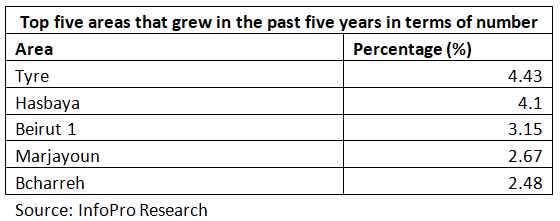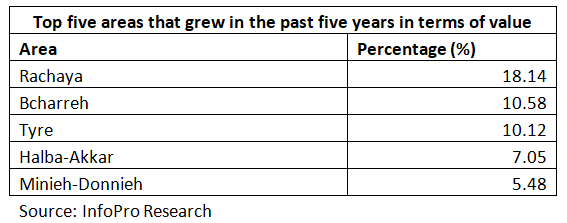Tyre, Hasbaya, Marjayoun
are top property destinations
Southern areas witnessed highest growth in registration
| Share |
|

|
|

|
|
|
|
A handful of areas outside of Beirut, some remote and very far, saw the highest property registration on average in the past five years, according to calculations conducted by InfoPro based on public figures published by the General Directorate of Land Registry and Cadastre (GDLRC).
Tyre showed the highest Cumulative Annual Growth Rate (CAGR) in the 2014-2018 period, recording a 4.4 percent growth in the number of transactions. It was followed by Hasbaya (4.1 percent), and Marjayoun (2.6 percent).
The GDLRC releases monthly figures related to the value and number of property sales transactions, divided according to cadastral office. Each office is in charge of a number of ‘sub-areas’. Figures were calculated according to these sub-areas.
The value of transactions was highest in Rachaya (18 percent), followed by Bcharreh (10.6 percent) and Tyre (10.1 percent).
It is worth noting that the increases in the number of transactions over the past five years are slight in all areas, compared to the significant increases in values.
Transactions fell back in Tripoli and Koura in favor of further areas like Halba-Akkar and Minieh-Donnieh.
The number and value of transactions in Metn fell progressively in all its districts. The value dropped the most in Mkalles, Broumana, Zalka, Dekouaneh, and Sakiet el Misk.
The GDLRC divides Beirut into four districts: Beirut 1 includes Ashrafieh, Bachoura, Saifi, Mdawar, and Marfaa. Beirut 2 includes Mousseitbeh and Zkak el Blat. Beirut 3 includes Mazraa, Ain El Mreisseh, and Minet El Hosn. Beirut 4 consists of Rmeil and Ras Beirut.
The CAGR of the number of transactions in Beirut 1 grew the most (3.15 percent), followed by Beirut 2 (0.52 percent), and Beirut 4 (0.43 percent). The CAGR in Beirut 3 dropped by 1.7 percent.
The CAGR of the value of transactions in Beirut 1 grew the most (2.6 percent), followed by Beirut 2 (1.2 percent). The CAGR in Beirut 3 and 4 dropped 1.2 and three percent respectively.


Reported by Yassmine Alieh
Date Posted: Feb 06, 2019
| Share |
|

|
|

|
|
|
|